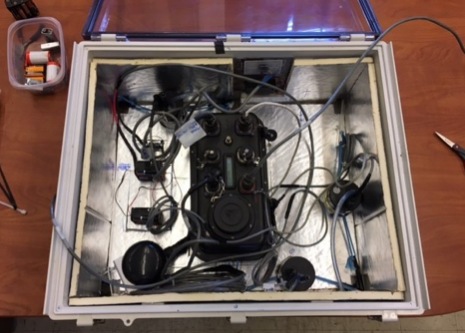Purpose of the flight and payload description
The objective of the flight was to test a new technology capable of converting low frequency sound microphones and a triaxial accelerometer hanging from a balloon into a ''seismometer". Future application of this is long duration surface seismic monitoring of Venus.
Current balloon-borne earthquake sound detectors lacks dof irection-of-arrival information and poorly distinguish signal from local noise. So this development comes to fill the need for a single balloon-borne acoustic sensor that can resolve elevation angle and azimuth of incident waves.
The payload that we can see in the image at left was composed of two 60 x 60 x 60 cm units each weighing <10 kg and drawing 4 W of power. Units were separated vertically by 30 m and contained each one 2 InfraBSU microphones, a triaxial accelerometer (Episensor or Adafruit ADXL), an Inertial Sense uIMU, and two Omnirecs Datacube digitizers.
Details of the balloon flight
Balloon launched on: 7/10/2020 at 13:35 utc
Launch site: Lemitar, New Mexico, US
Balloon launched by: Raven Aerostar
Balloon manufacturer/size/composition: Zero Pressure Balloon Aerostar Cyclone
Flight identification number: HBAL0414
End of flight (L for landing time, W for last contact, otherwise termination time): 7/10/2020 at 20:43 utc
Balloon flight duration (F: time at float only, otherwise total flight time in d:days / h:hours or m:minutes - ): 7 h
Landing site: Last known position near St. Johns, Arizona, US
External references
- Flight Test of a Balloon-borne Aeroseismometer NASA Flight Opportunities website
- Infrasound direction of arrival determination using a balloon-borne aeroseismometer JASA Express Letters 2, 054001 (2022)
15797If you consider this website interesting or useful, you can help me to keep it up and running with a small donation to cover the operational costs. Just the equivalent of the price of a cup of coffee helps a lot.


